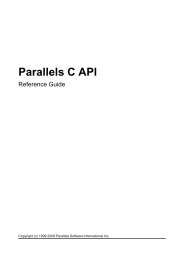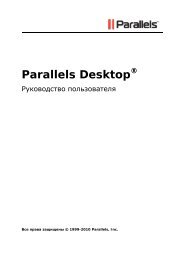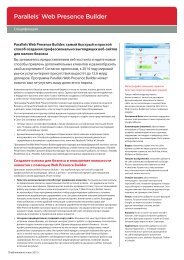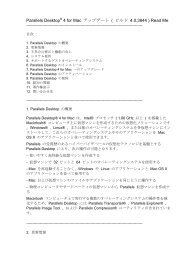- Page 1 and 2:
Parallels Server 5 Bare Metal User'
- Page 3 and 4:
Contents Introduction .............
- Page 5 and 6:
Contents Making Screenshots .......
- Page 7 and 8:
Contents Setting Up Private Network
- Page 9 and 10:
C HAPTER 1 Introduction This chapte
- Page 11 and 12:
Documentation Conventions Introduct
- Page 13 and 14:
Feedback Introduction If you spot a
- Page 15 and 16:
Learning Parallels Server 5 Bare Me
- Page 17 and 18:
Basics of OS Virtualization Learnin
- Page 19 and 20:
Parallels Server Bare Metal Configu
- Page 21 and 22:
Parallels Virtual Machines Learning
- Page 23 and 24:
Virtual Machine Files Learning Para
- Page 25 and 26:
Learning Parallels Server 5 Bare Me
- Page 27 and 28:
Learning Parallels Server 5 Bare Me
- Page 29 and 30:
Managing Virtual Machines and Conta
- Page 31 and 32:
Supported Guest Operating Systems M
- Page 33 and 34:
Choosing a Container ID Managing Vi
- Page 35 and 36:
Configuring Network Settings Managi
- Page 37 and 38:
Managing Virtual Machines and Conta
- Page 39 and 40:
Managing Virtual Machines and Conta
- Page 41 and 42:
Configuring the Default Directories
- Page 43:
Managing Virtual Machines and Conta
- Page 46 and 47:
Managing Virtual Machines and Conta
- Page 48 and 49:
Managing Virtual Machines and Conta
- Page 50 and 51:
Managing Virtual Machines and Conta
- Page 52 and 53:
Managing Virtual Machines and Conta
- Page 54 and 55:
Managing Virtual Machines and Conta
- Page 56 and 57:
Managing Virtual Machines and Conta
- Page 58 and 59:
Managing Virtual Machines and Conta
- Page 60 and 61:
Managing Virtual Machines and Conta
- Page 62 and 63:
Managing Virtual Machines and Conta
- Page 64 and 65:
Managing Virtual Machines and Conta
- Page 66 and 67:
Managing Virtual Machines and Conta
- Page 68 and 69:
Managing Virtual Machines and Conta
- Page 70 and 71:
Managing Virtual Machines and Conta
- Page 72 and 73:
Managing Virtual Machines and Conta
- Page 74 and 75:
Managing Virtual Machines and Conta
- Page 76 and 77:
Managing Virtual Machines and Conta
- Page 78 and 79:
Managing Virtual Machines and Conta
- Page 80 and 81:
Managing Virtual Machines and Conta
- Page 82 and 83:
Managing Virtual Machines and Conta
- Page 84 and 85:
Managing Virtual Machines and Conta
- Page 86 and 87:
Managing Virtual Machines and Conta
- Page 88 and 89:
Managing Virtual Machines and Conta
- Page 90 and 91:
Managing Virtual Machines and Conta
- Page 92 and 93:
Managing Virtual Machines and Conta
- Page 94 and 95:
Managing Virtual Machines and Conta
- Page 96 and 97:
Managing Virtual Machines and Conta
- Page 98 and 99:
Managing Virtual Machines and Conta
- Page 100 and 101:
Managing Virtual Machines and Conta
- Page 102 and 103:
Managing Virtual Machines and Conta
- Page 104 and 105:
Managing Virtual Machines and Conta
- Page 106 and 107:
Managing Virtual Machines and Conta
- Page 108 and 109:
Managing Virtual Machines and Conta
- Page 110 and 111:
C HAPTER 4 Managing Resources The m
- Page 112 and 113:
Managing Resources Managing CPU Sha
- Page 114 and 115:
Managing Resources Configuring the
- Page 116 and 117:
Managing Resources Configuring CPU
- Page 118 and 119:
Managing Resources Turning On and O
- Page 120 and 121:
Managing Resources Turning On and O
- Page 122 and 123:
Managing Resources Checking Quota S
- Page 124 and 125:
Managing Resources Moving Container
- Page 126 and 127:
Managing Resources Detaching Contai
- Page 128 and 129:
Managing Resources Configuring Netw
- Page 130 and 131:
Managing Resources Viewing Network
- Page 132 and 133:
Managing Resources Turning On and O
- Page 134 and 135:
Managing Resources Configuring Netw
- Page 136 and 137:
Managing Resources Configuring Prio
- Page 138 and 139:
Managing Resources Saved parameters
- Page 140 and 141:
Managing Resources This output show
- Page 142 and 143:
Managing Resources In this example,
- Page 144 and 145:
Managing Resources Configuring Lega
- Page 146 and 147:
Managing Resources Configuring Addi
- Page 148 and 149:
Managing Resources To revert to the
- Page 150 and 151:
Managing Resources Managing Contain
- Page 152 and 153:
Managing Resources Scaling Containe
- Page 154 and 155:
Managing Resources Applying New Con
- Page 156 and 157:
Managing Services and Processes Wha
- Page 158 and 159:
Managing Services and Processes Man
- Page 160 and 161:
Managing Services and Processes The
- Page 162 and 163:
Managing Services and Processes Cha
- Page 164 and 165:
C HAPTER 6 Managing Parallels Serve
- Page 166 and 167:
Managing Parallels Server Bare Meta
- Page 168 and 169:
Managing Parallels Server Bare Meta
- Page 170 and 171:
Managing Parallels Server Bare Meta
- Page 172 and 173:
Managing Parallels Server Bare Meta
- Page 174 and 175:
Managing Parallels Server Bare Meta
- Page 176 and 177:
Managing Parallels Server Bare Meta
- Page 178 and 179:
Managing Parallels Server Bare Meta
- Page 180 and 181:
Managing Parallels Server Bare Meta
- Page 182 and 183:
Managing Parallels Server Bare Meta
- Page 184 and 185:
Managing Parallels Server Bare Meta
- Page 186 and 187:
Managing Parallels Server Bare Meta
- Page 188 and 189: Managing Parallels Server Bare Meta
- Page 190 and 191: Managing Parallels Server Bare Meta
- Page 192 and 193: Managing Parallels Server Bare Meta
- Page 194 and 195: Managing Parallels Server Bare Meta
- Page 196 and 197: Managing Licenses Installing the Li
- Page 198 and 199: Managing Licenses Transferring the
- Page 200 and 201: Managing Licenses Viewing the Licen
- Page 202 and 203: Managing Licenses 202 key_number="P
- Page 204 and 205: Keeping Your System Up To Date Upda
- Page 206 and 207: Keeping Your System Up To Date 206
- Page 208 and 209: Keeping Your System Up To Date Upda
- Page 210 and 211: Keeping Your System Up To Date 210
- Page 212 and 213: Keeping Your System Up To Date Upda
- Page 214 and 215: Keeping Your System Up To Date Upda
- Page 216 and 217: Advanced Tasks Creating VZFS Symlin
- Page 218 and 219: Advanced Tasks Capabilities Defined
- Page 220 and 221: Advanced Tasks Creating Customized
- Page 222 and 223: Advanced Tasks # vzmktmpl /root/cen
- Page 224 and 225: Advanced Tasks 224 • %packages: a
- Page 226 and 227: Advanced Tasks # rpm -ihv /root/mys
- Page 228 and 229: Advanced Tasks Obtaining Server ID
- Page 230 and 231: Advanced Tasks Setting Immutable an
- Page 232 and 233: Advanced Tasks LowTotal: 8000 kB Lo
- Page 234 and 235: Advanced Tasks Loading iptables Mod
- Page 236 and 237: Advanced Tasks Creating Configurati
- Page 240 and 241: Advanced Tasks Checking partition a
- Page 242 and 243: Advanced Tasks The number of cylind
- Page 244 and 245: Advanced Tasks Running Parallels Se
- Page 246 and 247: C HAPTER 10 Troubleshooting This ch
- Page 248 and 249: Troubleshooting (The 65531 ports sc
- Page 250 and 251: Troubleshooting Saving Kernel Fault
- Page 252 and 253: Troubleshooting Failure to Start a
- Page 254 and 255: Troubleshooting Getting Technical S
- Page 256 and 257: Troubleshooting In this window, you
- Page 258 and 259: Troubleshooting Establishing Secure
- Page 260 and 261: C HAPTER 11 Glossary This glossary
- Page 262 and 263: Index Index A About This Guide - 9
- Page 264 and 265: Index Managing Memory Resources for


![[PDF] Parallels Server 5 Bare Metal](https://img.yumpu.com/18850617/239/500x640/pdf-parallels-server-5-bare-metal.jpg)
![[PDF] Parallels Desktop® 7](https://img.yumpu.com/18852044/1/190x245/pdf-parallels-desktopr-7.jpg?quality=85)

![[PDF] Parallels Python API Reference](https://img.yumpu.com/18850615/1/190x245/pdf-parallels-python-api-reference.jpg?quality=85)








![[PDF] Parallels Python API Reference](https://img.yumpu.com/18850529/1/190x245/pdf-parallels-python-api-reference.jpg?quality=85)

